Native Son: Life & Death; Entropy & Succession
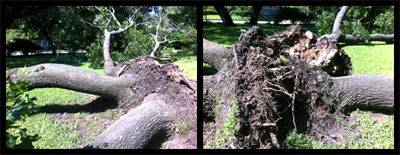
The great, four-trunked Shumard oak that fell overnight. Photos by Steven Chamblee except where noted.
Late morning now, and I have been bumbling through this day since I woke up at 1:30 a.m., slowly witnessing the grand plans I made yesterday fall apart. I had supposed I would launch up at 9 a.m. or so, supercharged from 11 hours of deep sleep and record-setting REM’s. Multi-tasking while mind-surfing to my new Brazilian Beat CD, featuring my new favorite song, “Ai Entao,” I’d have the truck cleaned out, the house tidied up, and the laundry hanging by noon. Instead, I sit here amid the clutter, mind rolling over with thoughts of Dennis Jones, my good friend who died recently.
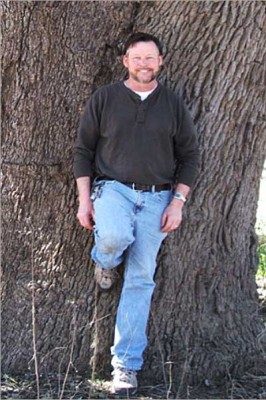
Dennis Jones shares a moment with a massive live oak near Goldthwaite, Texas, in 2011.
The logical side of my brain is okay with his passing … everything that lives must die, including me; he got a half-century (more than some get); he was well-respected and loved by lots of people. But the emotional side of my brain is having some issues. While I have certainly known people who died, what has me all akilter is that Dennis is my first close friend/peer to go. “The Gang” is now incomplete, and suddenly I realize this is just the start … this cycle will repeat until all of us are gone.
Just yesterday, I was called over to a garden to see if I could help with a large Shumard oak that had fallen overnight. By the time I pulled up, chainsaw music was filling the air, and sweaty men were busy piling brush into a dump truck. The once-mighty oak lay splayed out on the ground, each of its four trunks having fallen in a different direction. They had grown up as brothers, four acorns that fell in the same spot, or perhaps were buried in the same cache by a squirrel. Like human brothers, they were similar, but each one unique. The largest trunk was about 25 inches in diameter, the smallest about 18 inches. They grew as one from a 6-foot-wide hump of gnarled wood and roots that joined them not only physically, but intrinsically. What benefited one benefited the others; whatever harmed one, did so to the rest. To the objective arborist, this is basal inosculation; to me, it’s family.
The tree’s owner came out, obviously heartbroken about the loss, and spoke in broken sentences about how it didn’t make any sense. Yesterday, it was a wondrous living, breathing, immaculate being, the sentinel of majesty and memories … and now, it’s just gone; just a pile of awkward limbs that need to be chopped up and carted away. There was no warning, no telltale sign of the impending disaster … no chance to say goodbye. I know just how she felt, having cried without shame at the sight of massive trees toppled by storms that rolled over the Fort Worth Botanic Garden … trees I had talked to and learned from for years. Trees that helped me to grow into the person I am today.
In times like these, we all seek a way to make sense of it all, to somehow make at least a little bit of it right again. Even if you can’t bring your friend back, maybe you can make something beautiful come from the loss, if only to make sure the world remembers a little longer. Some people plant a memory tree; others install a bench or statue. Sometimes people establish scholarships, build libraries, dedicate parks, or erect monuments. The greater the loss, the larger the effort to keep a little of what is now gone.
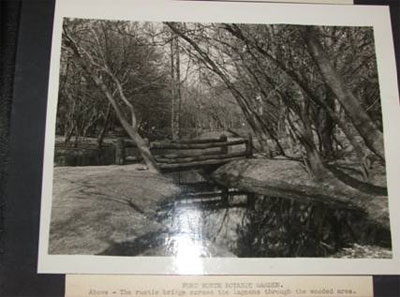
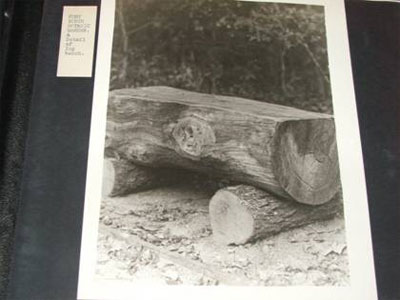
The rustic bridge and one of several log benches at the Fort Worth Botanic Garden in the 1930s. (Photos courtesy of the FWBG)
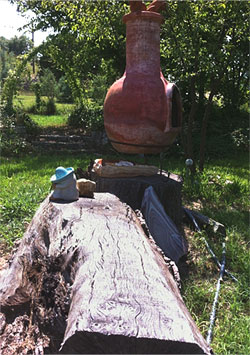
A rustic log bench and chiminea pedestal in the author’s garden.
The owner spoke of making rustic garden benches and perhaps having some lumber milled from the trunks. Personally, I’m hoping for the rustic benches, styled after those that graced the fledgling Fort Worth Botanic Garden back in the 1930s. Simple and earthy, they honor the past and present, yet they will not last forever. Nothing in this world lasts forever … and it shouldn’t.
Nature teaches us that everything and everyone have their time. Even the ancient redwoods and bristlecone pines have their time. And while we stand in awe of a tree that was already 1,000 years old during Christ’s lifetime, we know that it, too, will someday fall. We learn to simply appreciate the opportunity to share a brief moment in time with other beings, whether they are made of wood or flesh and blood.
Time changes everything, and the same natural laws that built something up will one day bring it down. And it has to be that way for the Earth to live. You can’t breathe in unless you exhale. There is no dawn without darkness. An oak can never grow tall in the shade of another.
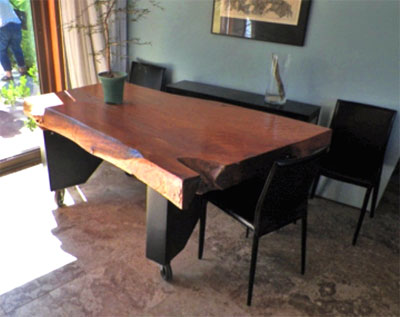
This table was created from a favorite tree that went down in a storm.
ne of the best examples of nature’s regeneration plan is right here in Texas, where the prairies are constantly undergoing a process of change that humans call “succession.” After a fire, pioneer species of grasses and forbs soon re-cover the land with vegetation. In a decade or so, woody plants begin to establish, and given time, will shade out the grasses. Long-lived species (oak, pecan, elm, etc.) will eventually shade out those first woody plants and dominate the land … until a fire or storm takes them down, and the process starts all over again.
Our understanding of nature’s methods is often limited because the cycles exceed our own lifetimes, making it difficult for us to comprehend unless we view ourselves as a part of nature, not apart from it. People who garden with their eyes open acquire this knowledge on a personal level, yet we are the very ones who suffer the most from natural changes because of our emotional attachment to living things. We value all forms of living things, not just the species that most resemble us. Anyone who has raised a puppy feels it’s more than just a dog. A cat that has shared your home for years is more than just a domesticated feline. And so it is natural to mourn the passing of a tree under which you have watched your children, then grandchildren, play.
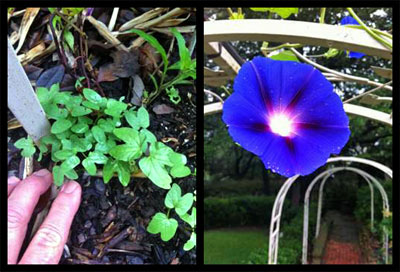
Seedlings of the morning glory crop that will yield beautiful blue flowers.
Still, there is the hard fact that everything that lives will die. We can’t change it, but we can change our reaction to it. We can temper our sorrow with action. We can honor the fallen by fostering the future. Dennis Jones did not want a funeral or burial place. He simply requested that people plant something beautiful or take a walk in the woods. I took this to heart, and planted 1,500 morning glory seeds at Chandor Gardens. It will be a glorious bloom that we will cherish and revel in for a few months this autumn. And if you are a gardener and know about the potential of morning glory seeds, you are smiling right now … knowing full well that we will always have morning glories in the garden. Doing something over the top and semi-ridiculous was my way of grieving, coping, honoring. I talked with him the entire time I was planting, and I could still see that marvelous twinkle in his eye as I dropped waaaay too many seeds in each area. The show will be great … the clean-up torturous. But I did it anyway. I just couldn’t help myself, and to paraphrase Flip Wilson … the Dennis made me do it!
About the author: Steven Chamblee is the chief horticulturist for Chandor Gardens in Weatherford and a regular contributor to Neil Sperry’s GARDENS magazine and e-gardens newsletter. Steven adds these notes:
It may be hot outside, but it’s always cool to visit Chandor Gardens. Come see caladiums, gardenias, hibiscus, zinnias, and lots more revel in the Texas summer. Go to www.chandorgardens.com for details. Just take I-20 west to exit 409, hang a right, go 2.1 miles and hang a left on Lee Avenue. Head straight 12 blocks and you’re driving in the gates. Call 817-361-1700 for more information.
I can always use another road trip! Let me know if you’d like me to come out and speak to your group sometime. I’m low-maintenance, flexible, and you know I like to go just about anywhere. No city too big; no town too small. Just send me an e-mail at stevenchamblee@yahoo.com and we’ll work something out.
